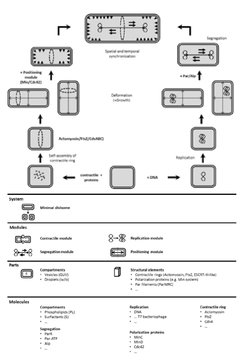Division
Work Package L4

Along with the splitting of the compartment and the replication of the genome goes the question how these processes may be spatially organized and orchestrated, such that both daughter compartments inherit the same amount of functional material. Thus, polarity and 3D structure formation are essential functionalities to be elucidated and reconstituted. This work package covers all mentioned aspects: there will be projects aimed at creating the forces to divide a droplet or vesicle compartment, both physically and biochemically.
Both, droplets and membrane vesicles will be thematized. With regard to a biochemical splitting machinery (a so-called “divisome”), we will focus on filament-forming and force inducing proteins from all three kingdoms of life. There will further be a focus on pattern and polarity induction, in order to define and functionally prepare the site of future division. Another aspect will be the characterization of how exactly cargo is distributed into two daughter compartments during an enforced division process. Finally, we will devise assays of how exactly chromosome segregation can be coupled to division in a minimal setting.
Our work in the different participating groups has brought significant breakthroughs. The Hyman Group has demonstrated how temperature-dependent nucleation of microtubule growth in phase-separated minimal systems can result in mechanical forces able to transform liquid containers. The Lipowsky Group and Dimova Group in collaboration with the Independent Research Group Wegner have shown how proteins may yield the autonomous deformation and symmetric fission of osmotically deswollen membrane vesicles. The Schwille Group continued purifying and characterizing protein systems from bacterial, archaeal and eukaryotic origin orchestrating polarization and cell division. In this context, the Lipowsky Group and Dimova Group are investigating the particularly important eukaryotic ESCRT-III system. The Spatz Group provides the technological platform for fluidically enforced compartment division and establishes a platform that enables membrane growth after fission. The Sourjik Group in collaboration with the Independent Research Group Mutschler establishes a routine for coupling nucleic acid replication and segregation to compartment division.
